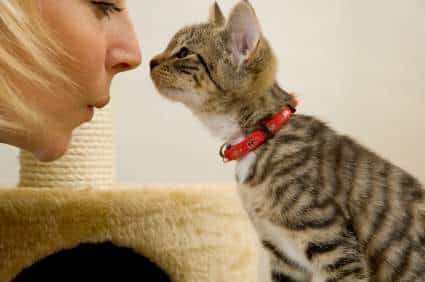
The most common disorder in cats is runny eyes. Infectious organisms such as the flu viruses or chlamydia cause conjunctivitis, an inflammation of the membranes lining the eyelids. This results in a discharge that is either watery and runny or thick and a greenish-yellow color. Occasionally a runny eye is caused by a disorder of the normal anatomy.
Tear glands continually produce secretions that lubricate the surface of the eyeball and flush particulate material into the tear ducts which then drain into the nose. If there’s a blockage of the ducts, the tears have no choice but to spill over and run down the face. Blockage can occur if there has been earlier damage to the ducts or if the cat has abnormal anatomy.
Persian cats frequently have tear staining, partly because their tear ducts are kinked and partly because their eyeball shape prevents effective drainage. Chronic tear overspill causes brown staining on the fur which is most noticeable in pale-colored cats.
Runny eyes are also a result of tear overproduction if there is an irritation to the sensitive eyeball. The cause may be easily identified as in some longhaired cats where a clump of hair rubs the surface. Some can be much more difficult to detect; solitary aberrant hairs may grow inside the eyelid and can only be discovered by carrying out an extremely thorough examination under general anesthetic.
The cornea is the clear outer covering of the eyeball and is a very sensitive structure. Flu infections can sometimes extend beyond the membranes and also affect the corneas. In very young kittens, the damage can be so severe that the cornea is extensively scarred and the cat grows up visually impaired or even blind.
Most corneal disease is encountered as a result of a bit of a punch up with another cat and a claw being poked in the eye. The puncture wound may be very obvious, particularly if a bit of claw is left behind in the eyeball. In other cases, there may be no apparent defects.
Mild corneal damage will heal well if the cat is supported with antibiotics but more severe damage may require surgery. Stitching the eyelids together often helps with the healing.
The iris is the structure that gives the eye its color, ranging from pink in albinos, to blue in Siamese, through all shades of yellows, coppers, and greens. The iris is a muscular structure that contracts and expands in order to vary the amount of light that passes through to the back of the eye.
It has very delicate blood vessels and if a claw has managed to pierce through the cornea to the iris, the bleeding can be very dramatic. Some of the more unpleasant feline infections, Feline Infectious Peritonitis (FIP) virus, Feline Leukemia Virus (FeLV), Feline Immunodeficiency Virus (FIV), and toxoplasmosis can all cause disease in the iris.
The first sign an owner may notice is a change in the color of the eye. Close examination reveals changes in the shape of the iris and the presence of debris in the fluid behind the cornea. It is very difficult to distinguish which one of these infections have caused the abnormality, so further investigation is always necessary.
If there is a diseased iris, also have to consider the possibility of a tumor. The two most commonly encountered are lymphosarcoma, a solid form of leukemia, and melanoma, a cancer of pigment-producing cells.
If an iris has been affected by a treatable condition, it may be left with permanent color change and a distorted shape because of adhesions or scar tissue produced during the healing response. Not all areas of new pigment are associated with the disease. Some cats, particularly orange-colored individuals, can develop little dark patches of pigment in the iris as they age, but any change in eye color should always be checked by your vet.
The retina is a fine membranous structure that lines the back of the eyeball. Light passes through the pupil and the lens and lands on the retina. There it stimulates nerve endings which cause electrical signals to be sent to the brain where the information is interpreted as vision.
Any abnormality of the color, the reflectivity, or the blood vessels indicates disease of the retina. One of the most serious conditions is a generalized degeneration of the retina. The retina appears to be very bright. Blood vessels become much finer and in advanced cases are barely visible.
The retina can detach from the underlying tissue if there is a leakage or overproduction of fluid between the layers, or if there is bleeding. High blood pressure resulting from kidney failure or an overactive thyroid gland can cause this eye problem.
Retinal detachments tend to be quite dramatic in onset and owners report that the cat appears to have gone blind overnight. The pupils are massively dilated and instead of a smooth concave surface, there are billowing folds of the retina. There is virtually no hope of restoration of eyesight in these cases.
The thought of a blind cat is quite horrifying to most owners but a combination of the cat not knowing it’s supposed to worry about its lack of vision and its other senses being so well developed means they actually cope remarkably well. If the environment is kept as constant as possible, most individuals adapt very well to their surroundings.
Many problems in cats are self -limiting and given one or two days most will rectify themselves. Eye conditions should be treated with a little more respect and a little more urgency even if the cat appears to be totally indifferent to its problem. A mild disorder can result in quite dramatic and devastating changes to the eye if left untreated so don’t delay and seek expert advice as soon as possible.




